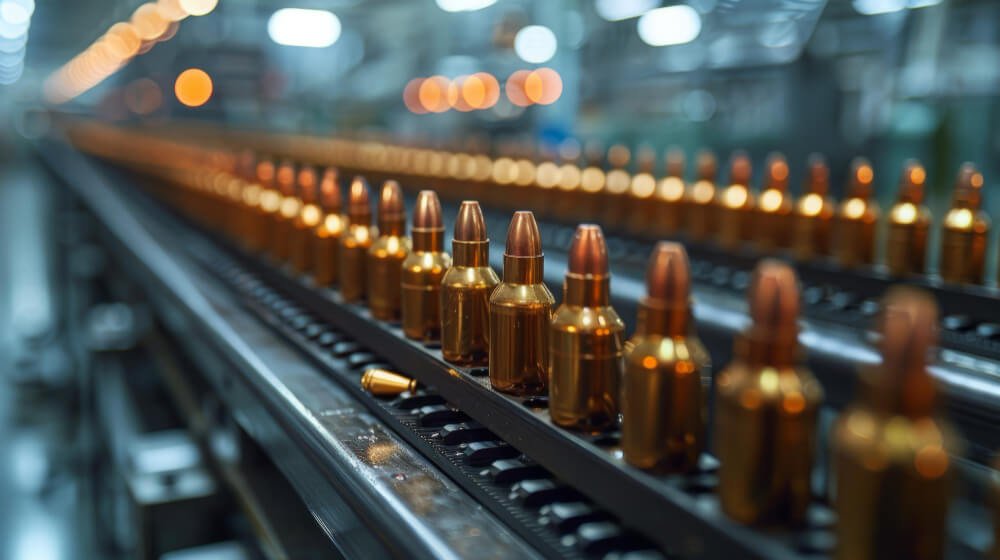The global ammo machines industry is undergoing a major transformation fueled by automation, digitalization, and smart manufacturing systems. What once depended on manual craftsmanship and mechanical precision is now powered by AI-driven automation, robotic assembly lines, and data-integrated production control.
This industrial shift marks a defining moment for ammunition manufacturing, improving efficiency, reliability, and product consistency while reducing waste and operational risks. The modern ammunition plant is no longer just a mechanical facility — it is a connected, intelligent ecosystem.

In the past, ammunition production relied heavily on manual or semi-automatic equipment. Each step — from cartridge assembly to inspection and packaging — was performed separately, often resulting in inconsistent quality and slower output.
The introduction of automated ammo machines revolutionized this model. By combining robotics, computer-controlled precision, and real-time monitoring, manufacturers can now produce thousands of units per hour with exceptional accuracy.
Ammunition assembly machines automate the complex process of combining primers, casings, propellants, and projectiles. Through servo-controlled mechanisms and intelligent calibration, these systems ensure each cartridge meets dimensional and ballistic standards with minimal variation.
Ammunition loading machines handle one of the most critical phases of manufacturing — powder charging and projectile seating. Modern loading machines use adaptive AI algorithms to maintain consistent powder fill and crimping force, ensuring safety and uniform ballistic performance.
Maintaining strict quality control is vital in the defense industry. Ammunition inspection machines use ultrasonic sensors, laser measurement, and X-ray systems to detect imperfections. These machines record real-time data, enabling predictive maintenance and immediate process corrections.
The final step of production involves ammo packaging machines, which automatically count, sort, and seal ammunition for shipment. Integrated labeling systems and barcode scanners guarantee traceability and compliance with global export standards.
AI and machine learning are redefining ammunition production by enabling predictive analytics and self-optimizing machines. For instance, if an assembly line detects deviation in projectile seating depth, the AI system immediately recalibrates the process, preventing large-scale waste.
Robotics has brought both speed and safety to ammunition manufacturing. Automated robotic arms handle delicate or hazardous components without fatigue, maintaining a perfect rhythm of operation while reducing workplace risks.
With IoT connectivity, ammo machines communicate seamlessly across all production stages. Each component — from loaders to inspection units — shares data to enhance traceability, production speed, and energy efficiency. IoT-driven systems support remote diagnostics and real-time performance tracking.
Environmental considerations are now a central pillar in the industry. New ammunition production machines are engineered for lead-free materials, energy-efficient motors, and closed-loop cooling systems. Manufacturers are investing in eco-friendly packaging and recycling processes to reduce their carbon footprint.
The automation revolution has dramatically improved all key performance indicators in ammunition manufacturing:
Higher Output: Modern ammo machines can produce up to ten times more units per hour than manual systems.
Improved Consistency: Computer-controlled calibration ensures identical pressure and dimension values across batches.
Enhanced Safety: Human exposure to explosive materials is minimized through robotic handling.
Data-Driven Traceability: Every step of production is digitally logged for full quality assurance and regulatory compliance.
These innovations have positioned companies like Yeter Munitions and other global leaders at the forefront of smart ammunition manufacturing.
To maintain military-grade standards, modern facilities integrate ballistic and impact testing equipment directly into production lines. These systems measure projectile velocity, chamber pressure, and structural resistance under controlled test conditions.
When combined with automated feedback loops, this testing data allows manufacturers to fine-tune every stage of production, creating a continuous cycle of improvement and validation.
While automated systems offer long-term savings, the initial investment for advanced ammo machines can be high. Modular designs and scalable automation solutions are helping smaller manufacturers enter the market more easily.
The industry’s evolution demands a technically skilled workforce. Operators now need expertise in robotics, PLC programming, and system diagnostics — prompting companies to prioritize training and digital literacy.
Strict international laws govern ammunition production and export. Manufacturers are turning to blockchain documentation systems to ensure transparency, security, and full traceability throughout the supply chain.
The next wave of innovation will focus on self-learning ammo machines capable of analyzing material behavior, optimizing energy use, and autonomously adapting to external variables. This evolution will mark the transition from automation to true autonomous manufacturing.
The revolution in the ammo machines industry signifies a paradigm shift — from mechanical repetition to intelligent automation. The integration of AI, robotics, IoT, and sustainability has created a more efficient, reliable, and environmentally responsible manufacturing ecosystem.
In the near future, ammunition factories will function as fully digital production networks, capable of predicting maintenance needs, optimizing energy consumption, and delivering flawless quality in every unit produced.
Companies embracing these advancements are not only achieving higher efficiency but also contributing to a safer, smarter, and more sustainable defense industry worldwide.